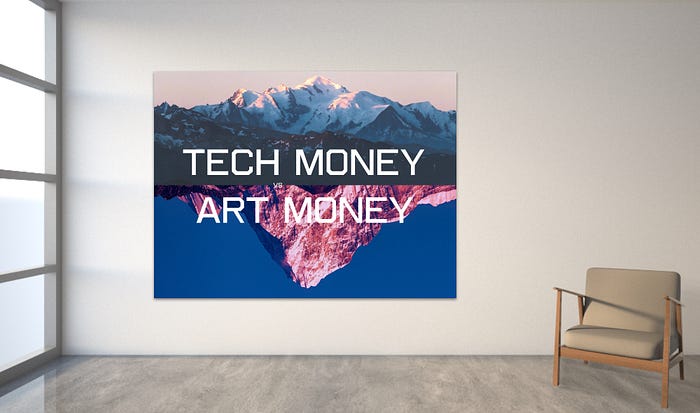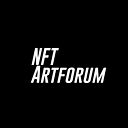Oral history interview with Rulton Fyder
An interview of Rulton Fyder conducted on Mar 13, 2021, by Emily Cobel, for the Archives of NFT ArtForum.
Biographical/Historical Note
Rulton Fyder is a multi-media artist in Red Lodge Montana and New York, N.Y. Emily Cobel is an art critic from Los Angeles, California.
Provenance
This interview is part of the Archives of Contemporary NFT Art Oral History Program, started in 2021 to document the history of the NFT arts worldwide, primarily through interviews with artists, historians, dealers, critics and administrators.
Preface
The following oral history transcript is the result of a tape-recorded interview with Rulton Fyder on March 13, 2021.
Emily Cobel has reviewed the transcript and have made corrections and emendations. The reader should bear in mind that he or she is reading a transcript of spoken, rather than written, prose.

Transcript
MS. COBEL: This is Emily Cobel, interviewing Rulton Fyder at the NFT ArtForum.
MR. RULTON: And you should say Rulton.
MS. COBEL: Rulton, sorry.
MR. RULTON: Not Fyder.
MS. COBEL: Okay, That’s a good place to start. So I think we’d like to start with your upcoming show at Pulpo Gallery. The name of the show is Capturing the Current Zeitgeist: Rulton Fyder in Dialogue With Conceptual Art Contemporaries. Actually, you know what, I’ll just open the conversation polemically. Why dialogue and why you?
MR. RULTON: I think in resonance and how to engage with an audience with a sense of familiarity. And if you see my work, I achieved that sense of familiarity with not a single image from the artists I’m having virtual dialogues with. I think to understand my works one has to strategically sort of rethinking how works of art are presented in different times and how would an artist best document his or her time with conceptual art. In order for the work to work, I have to think about the historical context of things, whether I have done my job as an historian, an archiver with art as my weapon of choice.
MS. COBEL: Did you face any push backs for the works you do such as copyright issue?
MR. RULTON: Mostly from people with no understanding of art history, overall if one cares to read some art history one will learn about appropriation and many great ones before me such as Sturtevant, Richard Pettibone, Sigmar Polke, one will know that there’s absolutely no copyright concern within my work as I used completely new images and motifs none used by the artists I had virtual dialogues with, I would say I give new meaning and new birth to the works I do.
MS. COBEL: How do you see the current NFT movement and this particular moment in history?
MR. RULTON: The current NFT movement is fascinating but I will tread with caution, because it’s very early and curation is non-existent, even with some of the exclusive invite-only platforms, you have works loosely categorized together and not engaging in meaningful dialogues or making fine art presentable in a fine art setting. I think it’s one of the curses of being in the technology early and I’m sure the teams behind those NFT platforms are learning and adapting and thinking of ways to improve the curation of the platform.

MS. COBEL: What do you think caused this loose curation?
MR. RULTON: Many things, such as whether this audience is ready for fine art as many of their collecting focus is about nostalgia and childhood, especially nostalgia and childhood of the millennials as they are mostly the forces behind this crypto blockchain movement, many young people benefited early recognizing this token system from their game playing days. So they will gravitate towards a video-game sci-fi type of graphic, and not much knowledge about the fine art side of things such as how to understand a Baldessari, or a Judd or a Matthew Barney performance work. Also, the platforms being tech-oriented and mostly with design or developer backgrounds rather than fine art, as you know many of us in the fine art world are quite inept with technology and we sometimes can be too comfortable with what we have and fail to innovate enough. But one thing about fine art is the amount of knowledge and academia behind everything we do and that layer of academia of separating what is great art that may be archived and documented in art history versus others.
MS. COBEL: Interesting, also I would add the financial element of NFT which enables a quick flipping and makes it benefit artists as well?
MR. RULTON: That’s where it gets tricky, flipping as you know is always a dirty word in the traditional fine art world because if a collector flips an artist’s physical works, the artist will not get a single cent. While in NFT space every flip guarantees an artist to earn a percentage of royalty, which is huge and game-changing for the art world as artists can finally get a piece of pie long after their works left their studio. But inevitably, there are many things I will call digital trinkets circulating, not much art but purely financial vehicles for some to trade around like hot potatoes, I do not know how they function but they are running around and apparently no one cares much and many new NFT collectors see that and chase the tails, so they may be hurt in the long run if they are getting things purely based in hype, with not much art behind other than just cute looking digital trinkets.
MS. COBEL: How are you thinking of and working with time, especially with yesterday?
MR. RULTON: Dialogues, familiar dialogues in a new time, our new age and facing the new societal challenges and opportunities. Because people tend to be scared of technology in the fine art world, like I said we are used to the old way of things, you do good work, catch the right curator or gallerist’s eyes, he or she prepares solo show or group show for you at an early stage gallery, then your works get sold to some good collections and maybe picked up by an institution or two and then you move to a mid-stage gallery if you are lucky which means better private and institutional placements and then if you are more lucky you go to a blue-chip gallery and which fancy catalogues and top tier collections which guarantees you a place in art history. That’s quite a long summary but a run down of how things operate in yesterday and still in today. But with NFT that barrier is shifting, an artist can directly go to market and find collectors and institutions. And that makes many fine art world people scared and to ease that sense of uncertainty, my works that are completely unique yet with a sense of the familiarity of the old world will serve as a bridge for them to understand bits of NFT through my works. And on the other hand I think it’s fun for the non-art crowd to see my works and then dig into history and learn a bunch of fantastic artists’ names before me or currently not being so active in the NFT world.

MS. COBEL: Do you consider yourself a temporary prankster, or a lifelong practitioner of the artistic dialogue and being the bridge between the fine art world and NFT art world?
MR. RULTON: I do not think I’m a temporary prankster, as I’m hell-bent and full of ideas flowing to do my part and share with the fine art world I love the tremendously gigantic benefits NFT will bring to our art world, I will keep doing what I do till my last breath. Because it is that important for me, artist royalty for all artists in the art world and beyond. NFT tattooed on my face.
MS. COBEL: We can move on, but I do have one other question because a lot of people do ask questions and are very interested in your process of making work, which I think is very important. I mean, it’s an important part of your practice, to me.
MR. RULTON: Yes go ahead.
MS. COBEL: A lot of people ask questions about how much you involved the artists you are having virtual dialogues with early on.
MR. RULTON: Not at all, absolutely not at all. I think the dialogue is more crucial when it comes independently from me, without the virtual dialogue artist offering any suggestions or exchanging ideas, so it’s a complete my thinking and my thought process and how I will create and present the work documenting and archiving what I see, experience and feel. Then people now or in the future seeing the work can make judgments themselves whether the dialogues are meaningful or not. I have utmost respect for the artists I engage in virtual dialogues with, but I love to keep my art lense completely of my own.
MS. COBEL: One of the very important things I see about your works is at a time in NFT space when so many artists seem in art or in the game because they want to just sell stuff and make money, you are engaging in virtual dialogues full of art theory and history, bringing up names such as Joseph Cornell without ever mentioning the artist, kind of amazing and very unique way of using the sense of familiarity to evoke emotions.
MR. RULTON: Yes, how does this focus on money happen with many of the artists both in fine art space and NFT space? Because they do not dig into art history books and the mass media every day is hyping up art solely for its monetary value. It’s sad really, that it is hard to find an artist or collector to discuss the significance of a work such as Felt Suit with you for hours, most of the time the conversation goes to work placements and selling works. I mean yes selling and work placements are important for many artists to survive, but I do think one needs to first love art love creating and love art history to engage in creating with historical dialogues in mind, that’s how great works can be created. This mass culture and constant surrounding of consumption is driving many artists to chase dollar signs, but we will see a fair share of young and old traditionalists defending the academic and theoretical value of art in a historical context. And I salute to all of them.
MS. COBEL: Thank you, it’s great for you to share these, thank you.
MR. RULTON: Okay, so we’re going to take our heads and get out of here now?
MS. COBEL: We’re out of here; we’re done.
[END OF INTERVIEW.]
Last updated…Mar 19, 2021

